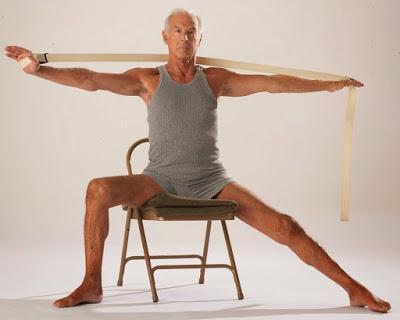
Eric Small, Iyengar Yoga Teacher
A neuron is the core component of the brain and spinal cord of the central nervous system and of the ganglia of the peripheral nervous system. Neurons by nature are electrically excitable cells that process and transmit information via electrical and chemical signals. These signals travel between neurons through specialized connections called synapses. Thus, neurons connect to each other to form neural networks. In order to ensure efficient communication between neurons and faster propagation of nerve impulses, some neurons are endowed with an insulating sheath called “myelin.” The molecular process of the synthesis of the myelin sheath is called “myelination.” The main purpose of the myelin sheath is to increase the speed at which electrical impulses propagate along the myelinated neuron to the next neighboring neuron. Myelination helps prevent the electric current from randomly leaving the axon thereby permitting agile communication for long-distance signaling and to sustain such signals.Myelinated axons are white in appearance, hence the term "white matter" of the brain. Under a microscope, myelinated axons appear like strings of sausages. The main constituent of myelin is cholesterol and it also has about 15–30% proteins. The predominant protein is myelin basic protein (MBP). For reasons that are still not clear, in some people, the body’s defense system recognizes the myelin basic protein as “foreign” and starts attacking it (Chronic Inflammation). This autoimmune inflammatory condition is multiple sclerosis (MS). When the body’s defense system lays seize on the myelin, the protective sheath loses its structural and functional integrity, resulting in disruption of the smooth neural communication. The more myelin is destroyed, the slower and less efficient the nerve impulses are. Eventually, as the disease progresses, it can cause the nerves themselves to deteriorate or become permanently damaged. While MS is not hereditary, having someone in the family with MS does significantly increase an individual's risk of developing the disease.
Signs and symptoms of MS will vary depending on the extent of nerve damage and which nerves get affected. The symptoms, severity, and duration can vary from person to person. Some people may be asymptomatic most of their lives, while others may suffer from severe chronic symptoms that never go away. Women are more than twice as likely to develop multiple sclerosis as men. MS usually affects people between the ages of 20 and 50 years, and the average age of onset is approximately 30 years. Common early signs of MS include: vision problems, tingling and numbness in joints, fingers, and toes, pains and spasms, weakness or fatigue, balance problems, dizziness, bladder issues, sexual dysfunction, and cognitive problems. As the disease progresses, symptoms become more severe.
There is currently no cure for MS. However, MS is not a fatal disease. In fact, MS patients have essentially the same life expectancy as the general population. Treatments can help speed recovery from the inflammatory attacks, modify the course of the disease, and manage symptoms. Physical and occupational therapies are a great way to manage the condition. While yoga does not cure MS, through its postures and breathing techniques, it helps to focus the mind and pay attention to the body. For example, for people with full-blown symptoms of MS, mornings can be an ordeal as the body is tight and rigid from the night’s sleep. The practice of yoga can ease many of the physical symptoms and improve the emotional upheaval through breathing and stretching exercises, and individuals are able to do successfully complete tasks and do things for the rest of the day with less pain and discomfort.
According to Eric Small, a senior Iyengar yoga instructor and author of Yoga and Multiple Sclerosis: A Journey to Health and Healing, Iyengar yoga techniques address many MS symptoms, such as loss of bladder control, balance, and fatigue. Eric has been practicing Iyengar yoga for nearly 50 years with his mornings devoted to asanas and his afternoons to pranayama. He credits Iyengar yoga with helping him maintain both balance and range of motion (Multiple Sclerosis and Yoga). And now several research studies discuss the benefits and potential role of yoga as an alternative treatment of symptom management for individuals with MS and describe how yoga can improve the patients’ quality of life (see Yoga, MS & Stress, Yoga, MS &Physiological Indices; Yoga, MS & Postural Balance and MS & Therapeutic Yoga). In all of the research studies, the opinion among MS subjects was unanimous: subjects reported improvements in mental and emotional health, concentration, bladder control, vision, and ability to withstand the pain better. Furthermore, subjects also revealed improved motor coordination, better capacities for walking without losing balance or coordination of gait, and improvement in being able to stand up from a sitting position.
In most of these research studies, for rehabilitative and/or maintenance treatments the emphasis was on asanas to improve strength and flexibility (Mountain pose, Warrior 1 and 2, and Arms Overhead pose), balance poses (using the wall and/or props to keep steady), and agility practices (start with slow, precise changes of position in asana practices, such a slow Sun Salutation). MS individuals can easily adapt the postures and use suitable props that will help them to do to the pose and benefit from it (Yoga Props We Can't Live Without). All of the research studies together with anecdotal reports are steps in the right direction as they show that a yoga program is very effective in improving the quality of life in MS patients.
Subscribe to Yoga for Healthy Aging by Email ° Follow Yoga for Healthy Aging on Facebook ° Join this site with Google Friend Connect

